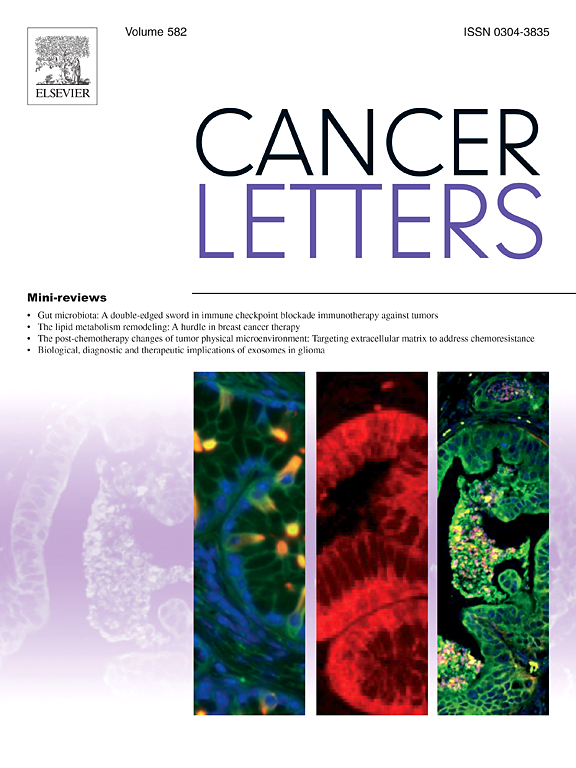Integration of transcriptomics, proteomics and loss-of-function screening reveals WEE1 as a target for combination with dasatinib against proneural glioblastoma
IF 9.1
1区 医学
Q1 ONCOLOGY
引用次数: 0
Abstract
Glioblastoma is characterized by a pronounced resistance to therapy with dismal prognosis. Transcriptomics classify glioblastoma into proneural (PN), mesenchymal (MES) and classical (CL) subtypes that show differential resistance to targeted therapies. The aim of this study was to provide a viable approach for identifying combination therapies in glioblastoma subtypes. Proteomics and phosphoproteomics were performed on dasatinib inhibited glioblastoma stem cells (GSCs) and complemented by an shRNA loss-of-function screen to identify genes whose knockdown sensitizes GSCs to dasatinib. Proteomics and screen data were computationally integrated with transcriptomic data using the SamNet 2.0 algorithm for network flow learning to reveal potential combination therapies in PN GSCs. In vitro viability assays and tumor spheroid models were used to verify the synergy of identified therapy. Further in vitro and TCGA RNA-Seq data analyses were utilized to provide a mechanistic explanation of these effects. Integration of data revealed the cell cycle protein WEE1 as a potential combination therapy target for PN GSCs. Validation experiments showed a robust synergistic effect through combination of dasatinib and the WEE1 inhibitor, MK-1775, in PN GSCs. Combined inhibition using dasatinib and MK-1775 propagated DNA damage in PN GCSs, with GCSs showing a differential subtype-driven pattern of expression of cell cycle genes in TCGA RNA-Seq data. The integration of proteomics, loss-of-function screens and transcriptomics confirmed WEE1 as a target for combination with dasatinib against PN GSCs. Utilizing this integrative approach could be of interest for studying resistance mechanisms and revealing combination therapy targets in further tumor entities.
整合转录组学、蛋白质组学和功能缺失筛选发现 WEE1 是与达沙替尼联合抗击原发性胶质母细胞瘤的靶点
胶质母细胞瘤具有明显的耐药性,预后不良。转录组学将胶质母细胞瘤分为易感神经亚型(PN)、间充质亚型(MES)和经典亚型(CL),这些亚型对靶向疗法表现出不同的耐药性。本研究旨在为确定胶质母细胞瘤亚型的联合疗法提供一种可行的方法。对达沙替尼抑制的胶质母细胞瘤干细胞(GSCs)进行了蛋白质组学和磷酸化蛋白质组学研究,并辅以shRNA功能缺失筛选,以确定敲除后能使GSCs对达沙替尼敏感的基因。利用SamNet 2.0网络流学习算法,将蛋白质组学和筛选数据与转录组学数据进行计算整合,以揭示PN GSCs中潜在的联合疗法。体外活力测定和肿瘤球状模型用于验证已确定疗法的协同作用。进一步的体外和TCGA RNA-Seq数据分析为这些效应提供了机理解释。整合数据后发现,细胞周期蛋白WEE1是PN GSCs的潜在联合治疗靶点。验证实验显示,达沙替尼和WEE1抑制剂MK-1775联合使用可在PN GSCs中产生强大的协同效应。达沙替尼和MK-1775的联合抑制作用会加重PN GSCs的DNA损伤,在TCGA RNA-Seq数据中,GSCs的细胞周期基因表达呈现出不同的亚型驱动模式。蛋白质组学、功能缺失筛查和转录组学的整合证实,WEE1是与达沙替尼联合治疗PN GSCs的靶点。利用这种整合方法可以研究耐药机制,并揭示更多肿瘤实体的联合治疗靶点。
本文章由计算机程序翻译,如有差异,请以英文原文为准。
求助全文
约1分钟内获得全文
求助全文
来源期刊

Cancer letters
医学-肿瘤学
CiteScore
17.70
自引率
2.10%
发文量
427
审稿时长
15 days
期刊介绍:
Cancer Letters is a reputable international journal that serves as a platform for significant and original contributions in cancer research. The journal welcomes both full-length articles and Mini Reviews in the wide-ranging field of basic and translational oncology. Furthermore, it frequently presents Special Issues that shed light on current and topical areas in cancer research.
Cancer Letters is highly interested in various fundamental aspects that can cater to a diverse readership. These areas include the molecular genetics and cell biology of cancer, radiation biology, molecular pathology, hormones and cancer, viral oncology, metastasis, and chemoprevention. The journal actively focuses on experimental therapeutics, particularly the advancement of targeted therapies for personalized cancer medicine, such as metronomic chemotherapy.
By publishing groundbreaking research and promoting advancements in cancer treatments, Cancer Letters aims to actively contribute to the fight against cancer and the improvement of patient outcomes.
 求助内容:
求助内容: 应助结果提醒方式:
应助结果提醒方式:


